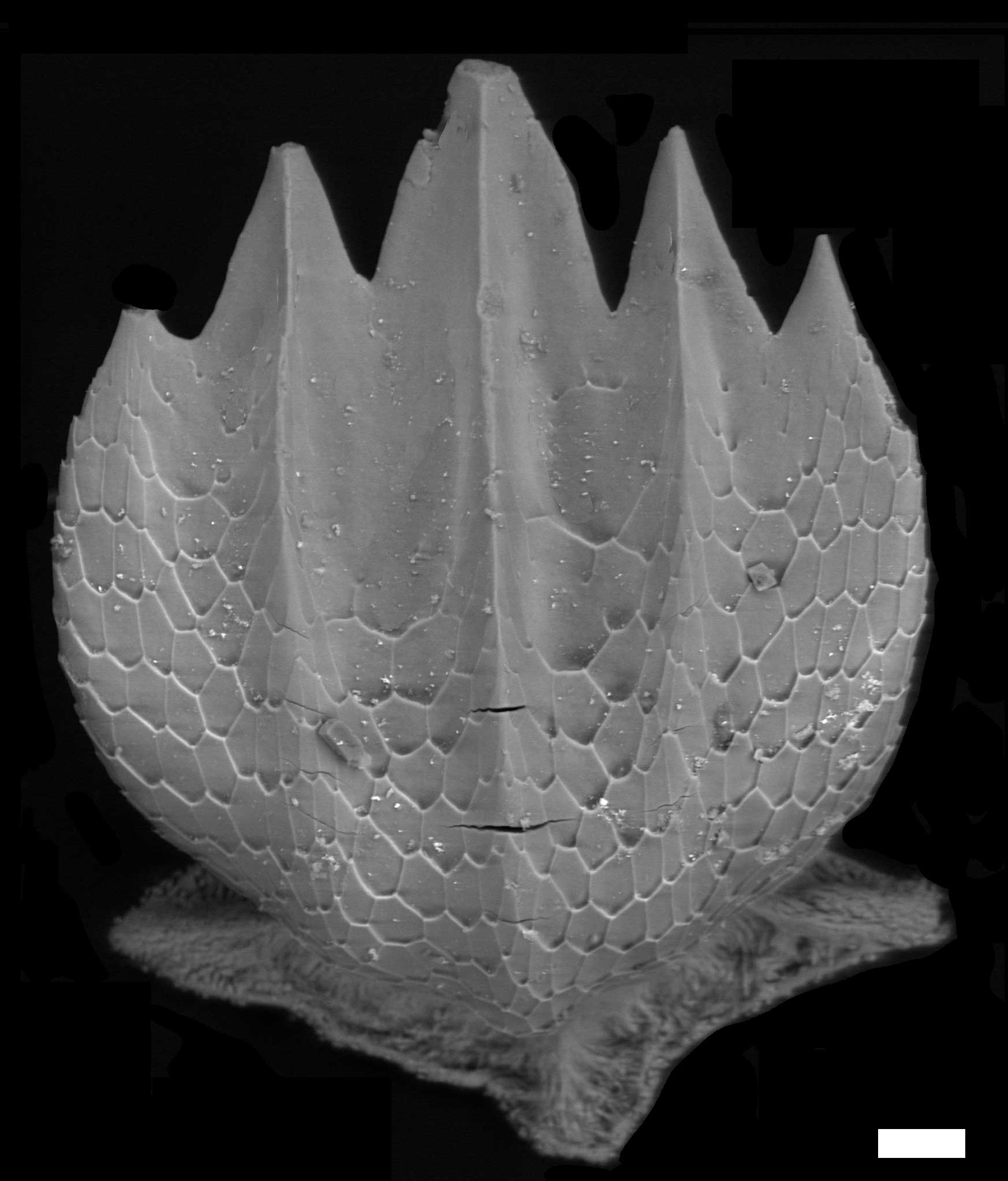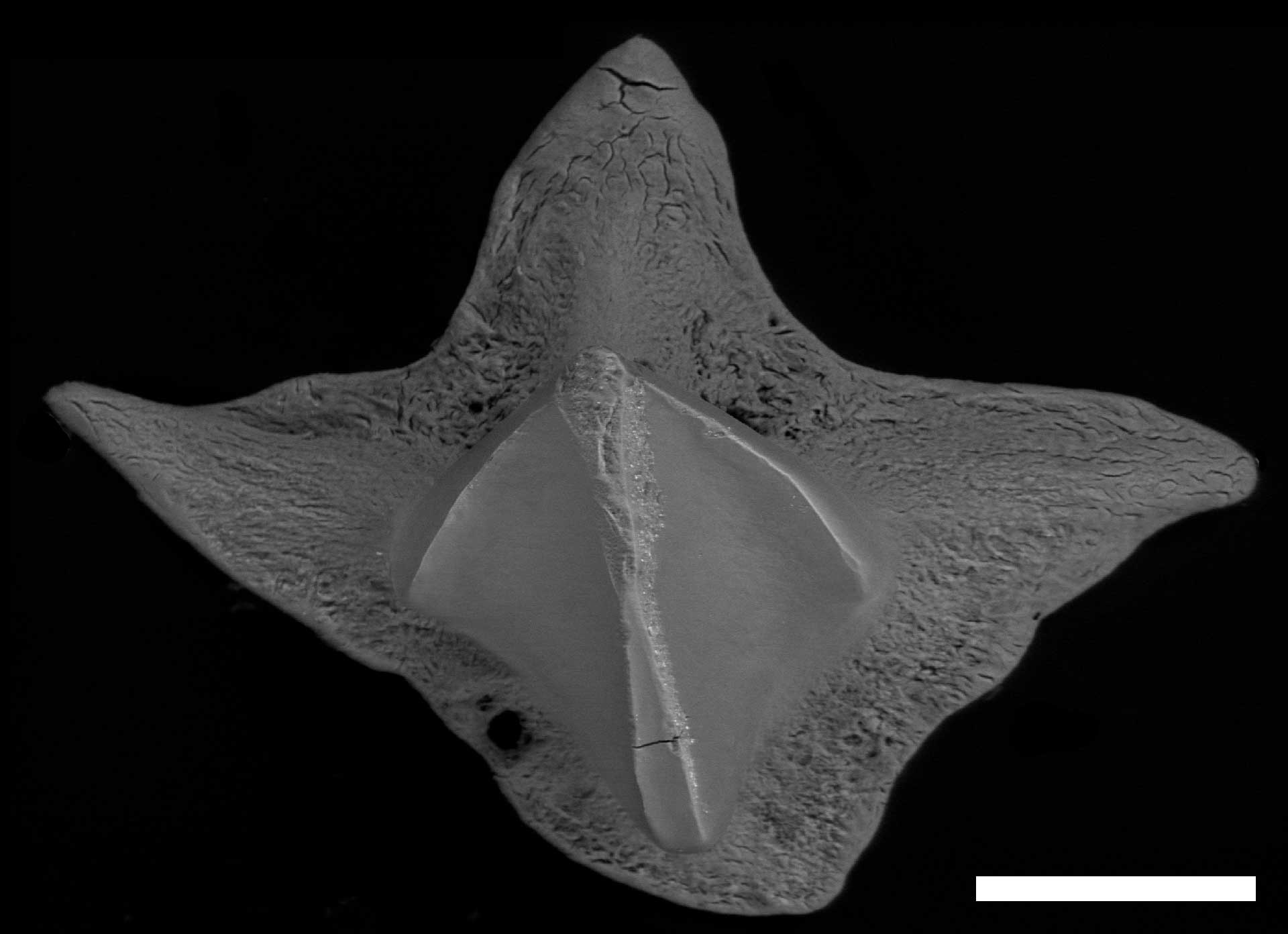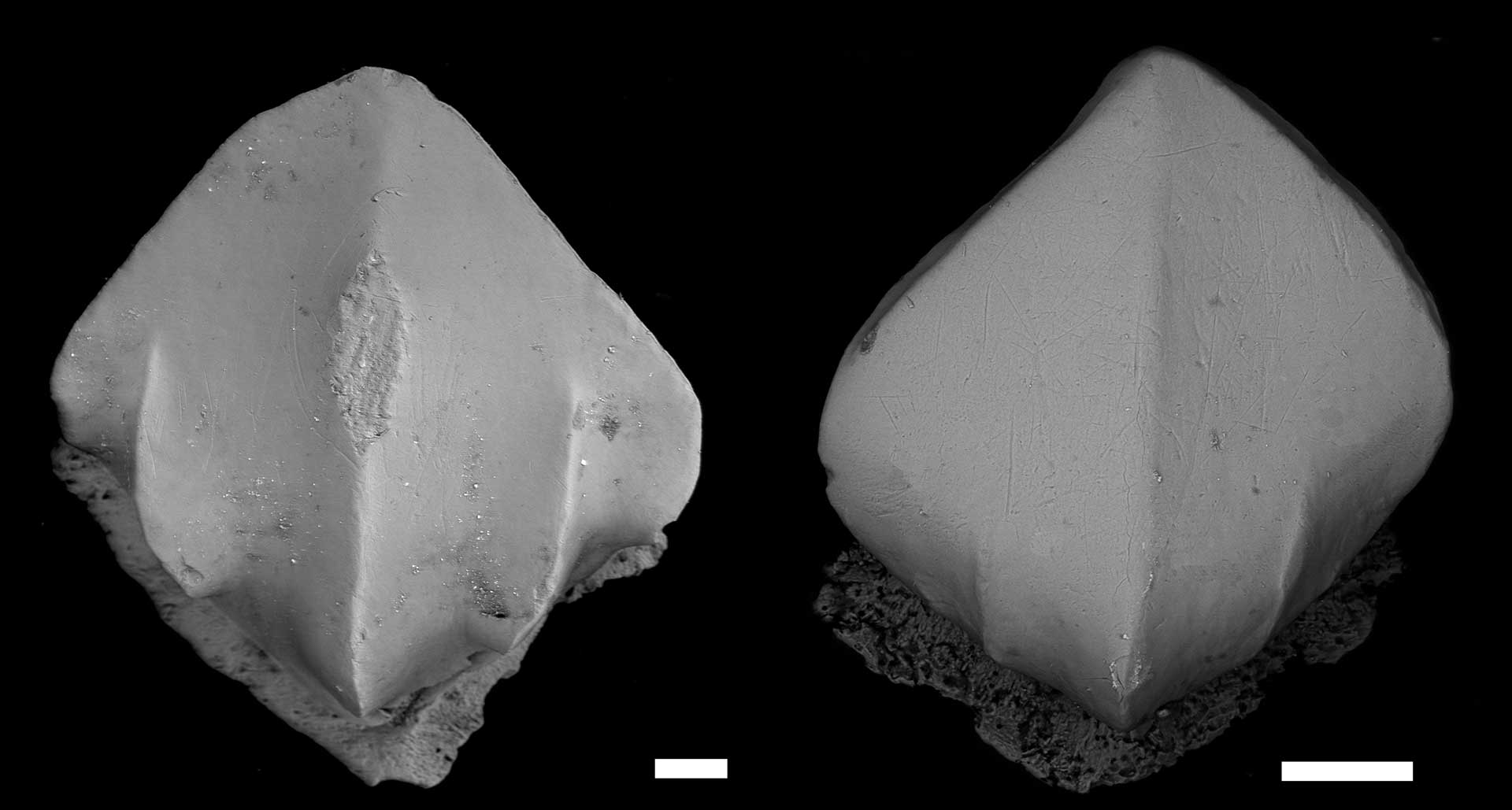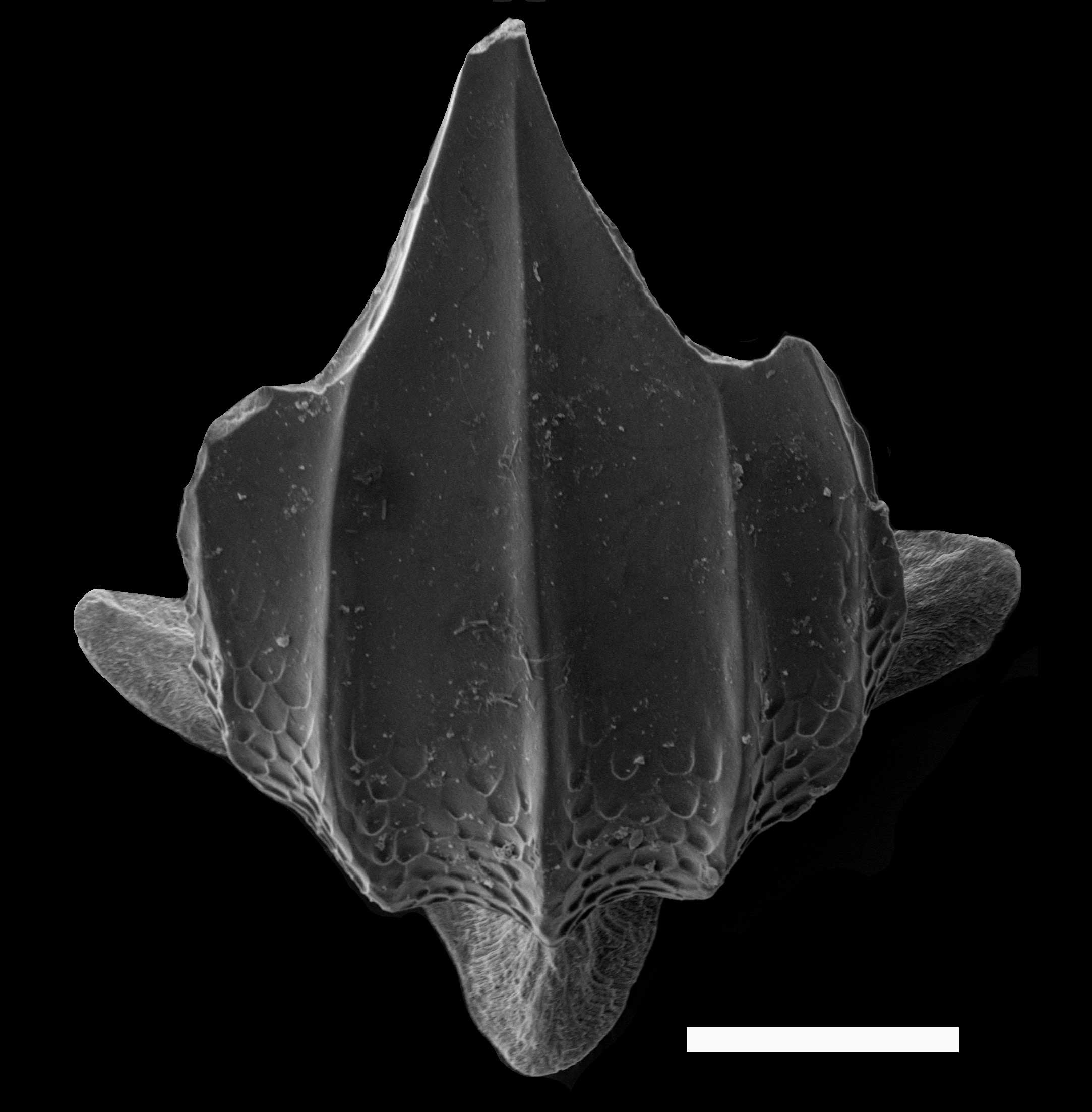A Shark’s Scale
Dermal denticles are the tooth-like scales that cover a shark’s skin. Studying dermal denticles that have been preserved in the recent fossil record is a completely new branch of shark science and is important for conservation. The denticles can tell us a lot about the habitat and behaviour of the sharks they came from, and with the aid of our reference collection of denticles we can work out which shark family they belong to. Then, by looking at the denticle’s physical traits, we can glean useful information about the function of that particular denticle as well as the lifestyle of the shark it belongs to. It’s a bit like a game of ‘Guess Who’.
To give you a better idea, let’s take a closer look at denticles from four sharks that you’ll probably recognise.
1) Common name: Great hammerhead
Scientific name: Sphyrna mokarran
Shark family: Sphyrnidae
IUCN status: Endangered
Habitat: Coastal and pelagic
Position of denticle: Body
Magnification: 275x, scale = 20µm
Function of denticle: To reduce drag

Great hammerhead. © Photo Erin Dillon & Jorge Ceballos
Take a look at this ornate denticle. How does its appearance reflect the life habits of its owner? First, consider the great hammerhead’s speed. Although it can be difficult to measure swimming speed, we do know that hammerheads are among the fastest of sharks. Their speed enables them to catch an assortment of prey that ranges from fish to crustaceans and other sharks – talk about an apex predator! Hammerheads are also known to migrate over long distances. It would therefore be useful for them to conserve energy by reducing some of the drag on their bodies as they slice through the water – and this is exactly what their denticles do.
• The parallel ridges running the length of the denticle crown (the top part of the denticle) end in serrated peaks that help to channel water around the shark’s body.
• The low height of the ridges and the thin spacing between them are ideal for disrupting the boundary layer between the skin and the surrounding water, reducing turbulence. In fact, the ridge dimensions of hammerhead denticles are very close to those projected for optimal burst swimming speeds. As the shark grows and sheds its denticles, the slightly larger replacements maintain the same ridge spacing but have more ridges to cover the additional surface area.
• The tiny honeycomb pattern is thought to play a hydrodynamic role at a finer scale. This ornamentation, which is barely visible without a scanning electron microscope, is also found on denticles in other shark families, but typically covers much less of the crown’s surface.
• The denticles of hammerhead sharks have evolved to be smaller and thinner, overlapping to provide a hydrodynamic coating rather than heavy armour. This reflects the sharks’ pelagic lifestyle and position higher up in the water column.
2) Common name: Tiger shark
Scientific name: Galeocerdo cuvier
Shark family: Carcharhinidae
IUCN status: Near Threatened
Habitat: Inshore, it frequents river estuaries, lagoons, harbours and atolls.
Position of denticle: Body
Magnification: 210x, scale = 100µm
Function of denticle: Possibly defensive

Tiger shark. © Photo Erin Dillon & Jorge Ceballos
The tiger shark differs from other sharks in that it tends to live in close association with the sea floor. Its denticles are very different from those of other members of the Carcharhinidae family and may be designed for defence rather than fast swimming.
• The denticles are thicker and have upward-pointing crowns. The upward angle of the crown would theoretically increase drag as the shark swims. This is counterintuitive, suggesting that the denticles may have a purpose other than hydrodynamics.
• The diverging and widely spaced ridges on the denticles have also been shown to be less hydrodynamic.
• The thick crown may protect the shark from getting scratched when it enters shallow water.
• It may help prevent parasites and other organisms, such as barnacles and algae, from settling on the shark’s body.
3) Common name: Nurse shark
Scientific name: Ginglymostoma cirratum
Shark family: Ginglymostomatidae
IUCN status: Data Deficient
Habitat: On reefs and in shallow water
Position of denticle: Body
Magnification: 69x (left), 125x (right), scale = 100µm
Function of denticle: Protection

Nurse shark. © Photo Erin Dillon & Jorge Ceballos
At night, nurse sharks prey on crustaceans and molluscs on the sea floor as well as fish and squid. They prowl along the rocky and coralline surface of reefs, using their hard, leathery hide to protect them from being scratched. This durable outer coating also makes it difficult for either predators or humans to eat them. Their distinctive dermal denticles are an important part of their body armour.
• Nurse shark denticles are typically thick and diamond-shaped with a single peak and are positioned side-by-side along the skin of the shark to form thick armour. Many may appear worn or scratched due to abrasions, as demonstrated in the denticles illustrated.
• Some denticles lack ridges altogether, whereas others possess large, widely spaced and incomplete ridges that may slightly improve the denticles’ hydrodynamic properties.
• The ridge spacing is significantly wider than that observed for other reef-associated shark families, reflecting the nurse shark’s slow swimming speed and helping us to identify the denticles.
4) Common name: Chain catshark
Scientific name: Scyliorhinus retifer
Shark family: Scyliorhinidae
IUCN status: Least Concern
Habitat: On the sea floor and in deep water on outer continental shelves
Position of denticle: Pectoral fin
Magnification: 200x, scale = 100µm
Function of denticle: general

Chain catshark. © Photo Erin Dillon & Jorge Ceballos
In some of Wolf-Ernst Reif’s seminal work investigating denticle function and evolution, the family Scyliorhinidae was documented to have ‘generalised function’ denticles, characterised by a well-developed central peak that is much longer than the adjacent peaks. This type of denticle is thought to be ancestral rather than adapted to serve any specific function. It also occurs on almost all sharks, albeit in varying numbers and on different parts of the body. On the chain catshark, this type of denticle takes precedence, covering most of the body and fins.
• The denticle’s complete, parallel ridges and fine microstructures may make it more hydrodynamic.
• The slightly upward-pointing angle of the central peak and medium thickness may help to protect the shark, given its demersal lifestyle.
• In previous studies, the denticles of mature female catsharks, specifically the lesser-spotted catshark, have been found to be longer and wider than those of mature males in certain areas, possibly providing additional protection from biting during mating.
Leave a Reply
You must be logged in to post a comment.